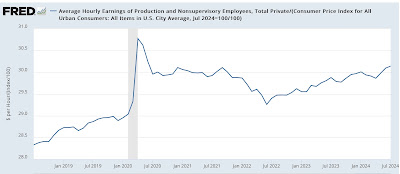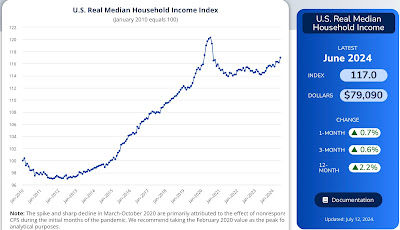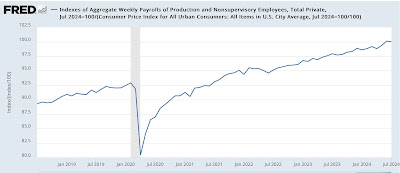– by New Deal democrat It’s a slow economic news week, so don’t be surprised if I play hookie tomorrow or Wednesday. In the meantime, now that we have July’s inflation data, we can update some “real” consumer well-being indicators. First, real average hourly wages for nonsupervisory workers rose 0.1% in July to a new all-time high excluding April through June 2020: It has risen 3.8% since its pre-pandemic all-time high, and 3.0% from its June 2022 post-pandemic low (when gas prices were /gallon). Meanwhile, Motio Research has updated their monthly calculation of real median household income through June. It is also at an all-time high excluding the months of March through August 2020: Note this includes pandemic stimulus
Topics:
NewDealdemocrat considers the following as important: US EConomics, well-being indicators
This could be interesting, too:
NewDealdemocrat writes JOLTS revisions from Yesterday’s Report
Bill Haskell writes The North American Automobile Industry Waits for Trump and the Gov. to Act
Bill Haskell writes Families Struggle Paying for Child Care While Working
Joel Eissenberg writes Time for Senate Dems to stand up against Trump/Musk
– by New Deal democrat
It’s a slow economic news week, so don’t be surprised if I play hookie tomorrow or Wednesday.
In the meantime, now that we have July’s inflation data, we can update some “real” consumer well-being indicators.
First, real average hourly wages for nonsupervisory workers rose 0.1% in July to a new all-time high excluding April through June 2020:
It has risen 3.8% since its pre-pandemic all-time high, and 3.0% from its June 2022 post-pandemic low (when gas prices were $5/gallon).
Meanwhile, Motio Research has updated their monthly calculation of real median household income through June. It is also at an all-time high excluding the months of March through August 2020:
Note this includes pandemic stimulus payments as well as wages, which is why it surged during the early months of the pandemic.
Finally, real aggregate payrolls for nonsupervisory workers – the best measure of the collective buying power of America’s middle and working class – declined -0.1% in July from its all-time high in June:
Although, per the BLS, Hurricane Beryl did not affect the employment or unemployment numbers for July, there is some indication that it *did* impact the number of hours worked, which declined -0.2%. This decline in hours explains why aggregate payrolls declined, even though real wages per hour worked increased.
If real aggregate payrolls fail to make a new high in the next couple of months, that would be cause for some concern, since the peak in this metric is a short leading indicator for recessions.
But all in all, real income in July continued the recent run of good news.
The Bonddad Blog
Real average nonsupervisory wages near, real aggregate nonsupervisory payrolls at, all-time highs Angry Bear, by New Deal democrat



